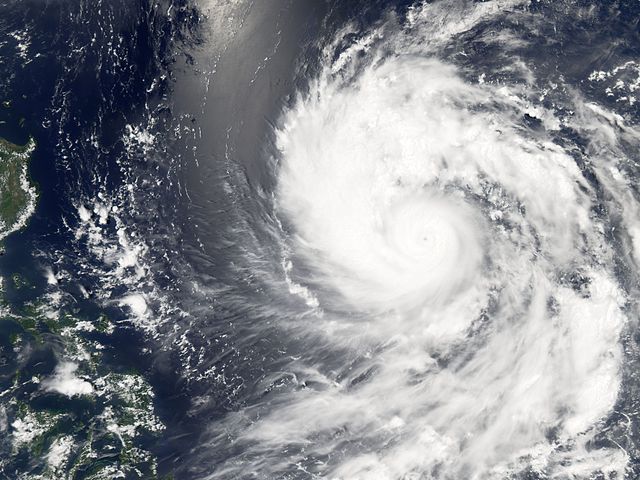 |
This is a file from the Wikimedia Commons. Information from its description page there is shown below.
Commons is a freely licensed media file repository. You can help.
|
Summary
| Description |
Typhoon Ewiniar formed in the western Pacific on June 29, 2006, a hundred miles south of the Yap Islands in the Federated States of Micronesia. The tropical depression gathered power and size as it traveled in a zigzagging fashion over the next several days, tracking northwest, then east, northwest again, then north. It passed almost directly through the Yap Islands before turning northwest yet again on a projected track towards the southern end of Japan. Fortunately for the island residents, Ewiniar was still a tropical storm during its passage through the island chain. As of July 4, 2006, Typhoon Ewiniar was 880 kilometers (550 miles) northwest of the Yap Islands. This photo-like image was acquired by the Moderate Resolution Imaging Spectroradiometer (MODIS) on the Aqua satellite on July 4, 2006, at 2:40 p.m. local time (04:40 UTC). The typhoon had a very distinct and clear spiral structure in this image, hinting at its intensity. Most of the islands of the area, including Yap, are hidden under the clouds, though the Philippines are visible well to the storm’s west. Sustained winds in the storm system were estimated to be around 200 kilometers per hour (125 miles per hour) around the time the image was captured, according to the University of Hawaii’s Tropical Storm Information Centre. |
| Date |
4 July 2006 |
| Source |
http://earthobservatory.nasa.gov/NaturalHazards/natural_hazards_v2.php3?img_id=13687 |
| Author |
NASA image by Jesse Allen, Earth Observatory, using data obtained from the Goddard Earth Sciences DAAC. |
Permission
( Reusing this file) |
| Public domainPublic domainfalsefalse |
 |
This file is in the public domain because it was solely created by NASA. NASA copyright policy states that "NASA material is not protected by copyright unless noted". (See Template:PD-USGov, NASA copyright policy page or JPL Image Use Policy.) |
|
|
|
Warnings:
- Use of NASA logos, insignia and emblems are restricted per US law 14 CFR 1221.
- The NASA website hosts a large number of images from the Soviet/ Russian space agency, and other non-American space agencies. These are not necessarily in the public domain.
- Materials based on Hubble Space Telescope data may be copyrighted if they are not explicitly produced by the STScI. See also {{ PD-Hubble}} and {{ Cc-Hubble}}.
- The SOHO (ESA & NASA) joint project implies that all materials created by its probe are copyrighted and require permission for commercial non-educational use.
- Images featured on the Astronomy Picture of the Day (APOD) web site may be copyrighted.
|
|
SOS Children's Villages has brought Wikipedia to the classroom. SOS Children's Villages cares for children who have lost their parents. Our Children's Villages give these children a new home and a new family, while a high-quality education and the best of medical care ensures they will grow up with all they need to succeed in adult life. There are many ways to help with SOS Childrens Villages.





